A Comprehensive Guide To Flat Roof Repairs
Posted 8.11.2025 | 9 Minute Read

Flat roofs are a popular choice for both commercial and residential buildings due to their cost-effectiveness and modern aesthetic appeal. However, like any roofing system, they require regular maintenance and occasional repairs to perform at their best. Understanding the basics of flat roof repair can help you identify problems early and make informed decisions about your roofing needs.
This comprehensive guide covers everything you need to know about flat roof repair, from identifying common issues to understanding repair methods and knowing when to call professional help. We’ll walk you through the essential steps for addressing flat roof problems and provide valuable insights to help you maintain your roofing system effectively. Here’s what we’ll cover:
- Common flat roof problems
- 8 essential steps to repair a flat roof
- Preventive maintenance for flat roofs
⭐️ Common Flat Roof Problems

Flat roofs present unique challenges compared to traditional sloped roofing systems. Their minimal slope design, while providing certain benefits, can lead to specific issues that demand proper attention and maintenance. One common problem is ponding water, which occurs when water remains on the roof surface for over 48 hours after rain. This can result from poor drainage, structural settling, or an inadequate slope, adding weight stress to the structure and causing membrane deterioration over time. Additionally, the roofing membrane, which acts as the primary barrier against water infiltration, is vulnerable to damage such as tears, punctures, and blistering. These issues often arise from foot traffic, falling debris, extreme weather, or regular wear and tear, potentially escalating into serious leaks if left unresolved.
Types of Flat Roof Materials
Understanding your flat roof material is crucial for determining the appropriate repair methods and materials needed for effective restoration.
- Built-Up Roofing (BUR): Traditional systems made of multiple bitumen layers and fabrics, offering durability and waterproofing. Repairs involve patching with compatible materials and protective coatings.
- Modified Bitumen: Combines the durability of BUR with easier installation. Repairs typically involve heat-welding patches or applying sealants.
- Single-Ply Membranes: Includes EPDM, TPO, and PVC materials. EPDM uses adhesive patches, while TPO and PVC require heat-welding for repairs.
- Liquid Applied Membranes: Seamless, flexible systems ideal for complex roof shapes, often applied over existing materials.
✅ 8 Essential Steps to Repair a Flat Roof

While some flat roof repairs require professional expertise, understanding the basic repair process helps you communicate effectively with contractors and make informed decisions about your roofing needs.
1. Safety Preparation and Assessment
Before tackling any leaking flat roof repairs, start by ensuring the roof is safe to access. Use proper safety gear, including non-slip shoes, gloves, and a safety harness if you’re working at heights. Avoid working in poor weather conditions, such as rain or strong winds, as this could increase the risk of injury or compromise the repair process. Thoroughly inspect the existing roof to determine the extent of the damage and identify problem areas. Take note of any structural concerns, hazards, or underlying issues that may affect the repair process. Proper preparation is key to effective flat roof maintenance.
2. Clean the Repair Area
A clean surface is critical for a successful repair, as debris and dirt can compromise the adhesion of roofing materials. Begin by clearing the damaged area of any debris, dirt, and loose material. Use a stiff brush or scraper to ensure the surface is spotless and free from dust or grime. If the leaking flat roof has accumulated water, ensure the area is completely dried before proceeding. This step is essential, as proper adhesion is crucial for durability and preventing future leaks.
3. Identify and Mark Damage Boundaries
To ensure a comprehensive flat roof repair, carefully identify the extent of the damage. Use chalk or tape to mark the boundaries of the affected area. This helps clarify which sections need attention and ensures you don’t miss hidden or minor damage that could worsen over time. Taking the time to mark the damage also makes it easier to measure and plan for the roofing material you’ll need, saving time and reducing waste.
4. Remove Damaged Materials
Carefully remove the damaged roofing material using a sharp utility knife or other cutting tools. Cut slightly beyond the visible damage to ensure you’re working with stable, undamaged material. This is especially important for flat roof repair options like patching or membrane replacement, as it provides a secure base for the new material. Create clean, precise edges to make the repair seamless and long-lasting. Be sure to properly dispose of any old or damaged materials during this step.
5. Prepare the Substrate
Inspect the underlying structure of the roof (the substrate) for any signs of damage, such as rot, cracks, or trapped moisture. These underlying issues can compromise the longevity of your repair if left untreated. Address these problems first by drying, leveling, or reinforcing the damaged substrate as necessary. A strong, even, and moisture-free base is essential for the success of your chosen flat roof repair options. Whether you’re patching, sealing, or replacing sections, this step ensures the repair material adheres properly and lasts over time.
6. Apply Primer and Adhesives
When it comes to flat roof repair, choosing the right primer and adhesive for your roofing material is crucial. Follow the manufacturer’s instructions carefully to ensure proper application. Apply the primer evenly across the repair area and allow it to dry completely before proceeding. This step is especially important for flat roof maintenance, as it ensures the patches or membranes will stick securely to the existing roof. Proper adhesion is vital for preventing further leaks and ensuring the repair remains durable.
7. Install Repair Materials
Cut repair patches or membranes to size, ensuring they extend beyond the marked damaged area to create a secure, watertight seal. Position the materials precisely over the repair area and use tools like rollers or brushes to smooth out wrinkles and ensure proper adhesion. Pay close attention to the seams and edges, as these are common areas where leaks can reoccur. Depending on your flat roof repair options, follow the manufacturer’s instructions for layering and overlapping the materials. This step is key to creating a long-lasting fix for a leaking flat roof.
8. Seal and Protect
Once the repair materials are installed, apply a waterproof sealant or protective coating to the area. This step not only blends the repair with the surrounding roof but also provides an additional layer of protection against water and weather damage. Proper sealing is especially important when considering flat roof repair costs, as it helps prevent future leaks and minimizes the need for repeat repairs. Allow sufficient curing time as specified by the product guide before exposing the repair to weather conditions. Regular inspections and flat roof maintenance are crucial to ensure the long-term performance of your repair and to catch any new issues early.
By following these steps, you can tackle flat roof repairs effectively and prevent further damage. With the right preparation, materials, and tools, you can save on flat roof repair costs and prolong the life of your flat roof.
🛠️ Preventive Maintenance for Flat Roofs

Regular maintenance significantly extends flat roof lifespan and reduces the likelihood of costly emergency repairs.
Regular Inspections
Schedule professional roof inspections at least twice a year, ideally during spring and fall, to catch seasonal wear and tear. After severe storms or extreme weather, take the time to inspect your roof for signs of damage like cracks, tears, or leaks, so you can address issues before they worsen.
Drainage Maintenance
Make sure drains, gutters, and scuppers are consistently clear of debris like leaves, branches, and dirt to maintain proper water flow. Blocked drainage can lead to ponding water, which increases the risk of leaks and structural damage over time. Regular cleaning ensures your roof stays in top condition.
Traffic Control
Limit foot traffic on your flat roof as much as possible to prevent unnecessary wear and tear. When access is unavoidable, create designated walkways or use protective materials to shield the roof’s surface. This helps avoid punctures, tears, or other damage caused by heavy or sharp objects.
Prompt Repairs
Don’t wait to fix small roofing issues, such as cracks, loose seams, or minor leaks. Addressing these problems early can prevent costly repairs or complete roof replacements down the road. Quick action ensures your roof lasts longer and performs better.
👨🔧 When to Call Professional Flat Roof Repair Services
While some maintenance tasks can be handled by property owners, many situations to repair flat roofs require professional expertise and specialized equipment.
Complex Damage
Extensive membrane damage, structural issues, or problems involving multiple roof areas typically require professional assessment and repair. These situations often involve underlying causes that need expert diagnosis.
Safety Concerns
High roofs, steep access areas, or repairs near electrical equipment present safety risks that are best handled by trained professionals with proper safety equipment and insurance coverage.
Warranty Considerations
Many roofing systems include warranties that require professional installation and repairs using approved methods and materials. DIY repairs may void these valuable protections.
Code Compliance
Roofing work often requires permits and must meet local building codes. Professional contractors understand these requirements and ensure compliance with all applicable regulations.
🏡 Your Trusted Partner for Flat Roof Repair
At Coastal Roofing of South Florida, we know how critical it is to have a flat roof you can rely on to protect your property. With years of experience, specialized expertise, and a dedication to quality, our team goes above and beyond to ensure your roofing needs are met with precision and care. Whether you need a minor repair or a complete flat roof restoration, you can trust us to deliver professional, efficient, and long-lasting results.
Serving communities from Fort Pierce to Boca Raton, we pride ourselves on being the go-to team for flat roof repair in South Florida. Ready to experience the Coastal Roofing difference? Contact us today for your free inspection, and let us show you why we’re the trusted choice for all your roofing needs.
Recent Articles
